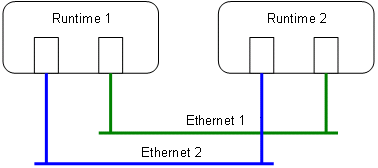
The T5 runtime version SR5 or later enables the use of the event driven protocol for binding variables with two redundant ETHERNET networks. This provide high security level for runtime exchanges over ETHERNET.
Dual binding is used in a redundancy network connection using 2 separate network segments. Both the unit publishing variables (producer) and the unit subscribing variables (consumer) has to be equipped with 2 Ethernet network interfaces:

Running dual binding on a T5 runtime require 2 separate Ethernet interfaces boards mounted in the runtime platform. Each Ethernet board must be setup separately to the 2 network segments used.
Configuration
Configuration of dual binding links is done using the Global binding Editor. To specify a dual link, you must specify for each related node two IP addresses instead of one. To do that, enter both IP addresses separated with a slash ("/") sign:

No further configuration is required. Both connections always refer to the same port number
Connection status
The "connection status" information remains available in case of dual binding configuration. In that case, the value of the connected variable reflects the status of both network connections.
The value stored in the variable is an integer with the status of the first connection in bits 0 to 3, and status of the second connection in bits 4 to 7:
![]()
Variable status
The "variable status" information remains available for each variable exchanged in a dual binding configuration. In that case, the value of the connected variable reflects the status of both network connections.
| 0 | OK |
| 1 | Connection 1 fails |
| 2 | Connection 2 fails |
| 3 | Both connections fail |